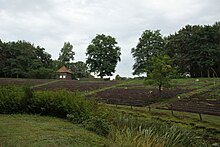Open-air stage Stedingsehre

The open-air stage Stedingsehre is a former Nazi cult site as part of the Thing movement in the Bookholzberg district of the Ganderkesee community. It should serve the ideological training of the political elite of the National Socialists. The name referred to the Steding War . The open-air stage held more than 20,000 people.
description
The facility consists of a semicircular grandstand open to the north with a ditch in front and the semicircle of the village square of the former play village of the open-air theater, which is now largely overgrown with dense vegetation. The play village extended to the north with a number of buildings.
history
On the occasion of the 700th anniversary of the Battle of Altenesch wrote the Oldenburg author August Hinrichs 1934, who had distinguished himself with Low German farces, the play, "De Stedinge" , which at the request of the Gauleiter Carl Röver on the purpose-built outdoor stage in Bookholzberg ( District of Oldenburg ) was listed several times between 1935 and 1937.
The events at the modern Thingstätte, which the NSDAP called " Oberammergau of the North" , should act as an ideological and political source of strength for all people in the Weser-Ems area . Based on the play, which was seen by a total of 150,000 visitors at the time, the open-air theater was nicknamed Stedingsehre . August Hinrichs left “the rights to his piece, which glorifies 'blood' and 'soil', to the Stedingsehre Foundation. Reichsstatthalter Röver holds the strings in his hand ”.
The "Low German Memorial Stedingsehre" was consecrated in 1937 by the Reich Propaganda Minister Joseph Goebbels as a "Normark Celebration Site". Mass rallies of the NSDAP took place here, later a training center of the party was to be set up there, but this did not happen after the outbreak of war. A solstice celebration was last held on the site in 1939 in the presence of Alfred Rosenberg .
A permanent small village was built on the theater grounds for the performances. In 1943 an aerial bomb destroyed the church.
The remaining buildings are still preserved today and house a facility of the Weser-Ems vocational promotion agency , which prohibits unauthorized access to the site by unauthorized persons. Considerations to reactivate the open-air theater have not been implemented against the background of historical events. The facility is now a listed building.
literature
- Gerhard Kaldewei: "Stedingsehre should become a place of pilgrimage for all of Germany". Documentation and history of a Nazi cult site on the Bookholzberg; 1934 - 2005. Ed. Oldenburgische Landschaft, Delmenhorst u. a. 2006, ISBN 3-939401-07-2 .
- Gerhard Kaldewei: Where German farmer's fists guide the plow through the mother earth. In: Oldenburger Jahrbuch 103 , Oldenburg 2003, pp. 107–167.
- Ulf-Thomas Lesle : Low German and the North German stage movement . In: Regional Fundamentalism? History of the homeland movement in the city and country of Oldenburg . Oldenburg 1999, pp. 198-217.
- Catrin Finsterhölzl: The inauguration of the Low German memorial site Stedingsehre. An example of National Socialist self-staging in the Gau Weser-Ems, In: Oldenburger Jahrbuch 99 , 1999, pp. 177–205.
Web links
- Stedingen in 1234 , pictures of the original condition of the Nazi cult site "Stedingsehre" from the time of National Socialism
Individual evidence
- ^ Stedingsehre Foundation (ed.): De Stedinge. Varel 1937, p. 5.
- ↑ Ulf-Thomas Lesle: Identity Project Low German. The definition of language as a political issue. In: R. Langhanke (Ed.): Language, Literature, Space. Fs. For Willy Diercks. Bielefeld 2015, p. 729.
- ↑ UWG Ganderkesee: Make place accessible - Stedingsehre ( page no longer available , search in web archives ) Info: The link was automatically marked as defective. Please check the link according to the instructions and then remove this notice. . February 9, 2012
Coordinates: 53 ° 5 ′ 54 ″ N , 8 ° 31 ′ 27 ″ E
